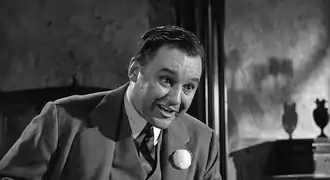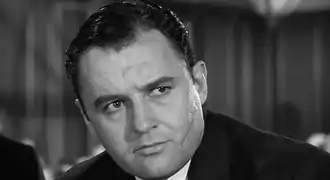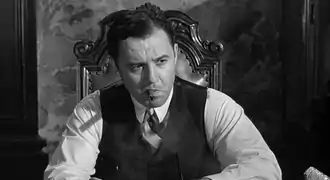Al Capone (film)
Al Capone is a 1959 biographical crime drama film directed by Richard Wilson,[4] written by Malvin Wald and Henry F. Greenberg, and released by Allied Artists. It stars Rod Steiger as Al Capone.
| Al Capone | |
|---|---|
.jpg.webp) Film poster by Reynold Brown | |
| Directed by | Richard Wilson |
| Produced by | Leonard Ackerman John Burrows |
| Written by | Malvin Wald Henry F. Greenberg |
| Starring | Rod Steiger |
| Narrated by | James Gregory |
| Music by | David Raksin |
| Cinematography | Lucien Ballard |
| Edited by | Walter Hannemann |
| Distributed by | Allied Artists |
Release date |
|
Running time | 104 minutes |
| Country | United States |
| Language | English |
| Budget | under $1 million[1] or $550,000[2] |
| Box office | $2.5 million (rentals)[3] |
Steiger reportedly refused the producers' first offer to star in this film because he thought the initial screenplay inappropriately romanticized Capone and criminality. In an interview Steiger said, "I turned the picture down three times." According to TCM, he agreed to play the role only after the producers agreed to rewrite.[4] The finished film was noted for its deglamorized portrayal of the subject.[5]
Plot
Chicago, 1919: A young Al Capone arrives to work for mob boss Johnny Torrio. He meets Torrio's top man, "Big Jim" Colosimo, who runs business and politics in the First Ward while secretly on Torrio's payroll.
Prohibition is enacted a year later, causing Torrio and other gangsters like Dean O'Banion, George "Bugs" Moran and Earl "Hymie" Weiss to compete for profits in bootleg liquor and beer. Torrio's rivals conspire to have Colosimo and his henchmen killed.
A reform mayor is elected, so Torrio and Capone change their base of operations to Cicero, a few miles away. Capone also has O'Banion killed and makes a play for Maureen Flannery, the widow of one of Colosimo's men.
Weiss and Moran return the favor by ordering Torrio to be shot. Capone retaliates by killing Weiss and forcing merchants throughout the city to pay for "protection." A sergeant in the Chicago police, Schaefer, is promoted to captain and vows to end the bloodshed and extortion and put Capone behind bars.
With the heat on from the cops, a crooked newspaperman named Keely tries to bribe Schaefer but fails. He persuades Capone to move to Florida until things cool down. From a safe distance, Capone masterminds the St. Valentine's Day Massacre, with several of Moran's men gunned down in a Chicago garage.
Capone and Moran call a truce, but when he learns Keely has been helping a Moran plot to kill him, Capone ends the reporter's life instead. Maureen finally has her fill of Capone's corruption and violence, while Schaefer and the feds find a way to finally put Capone away—on charges of tax evasion, earning him 11 years at Alcatraz.
Cast
- Rod Steiger as Al Capone
- Nehemiah Persoff as Johnny Torrio
- Fay Spain as Maureen Flannery
- Joe De Santis as Big Jim Colosimo
- Martin Balsam as Mac Keely (based on Jake Lingle)
- James Gregory as Schaefer
- Murvyn Vye as Bugs Moran
- Sandy Kenyon as Bones Corelli
- Clegg Hoyt as Lefty (uncredited)
Production
Films based on the lives of real-life gangsters had been banned under the Production Code. This ban was lifted in the late 1950s leading to films like Baby Face Nelson (1957). J. Edgar Hoover criticised the film and a proposed movie about Pretty Boy Floyd was dropped.[1] However, in 1957 Lindley Parons and John Burrows announced they would make a film about Al Capone for Allied Artists. Jack De Witt was assigned to write the script.[6][7]
The script was worked on by Mal Wald and Henry Greenberg who were known for doing true life stories, including an episode of Climax! about Albert Anastasia.[8][1]
Rod Steiger was cast in the lead. He had been reluctant to play the lead but was persuaded once he read the script.[1] Fay Spain was cast off the strength of her performance in a TV play.[9]
Filming started 16 September 1958.[10]
"This isn't just another crime drama aimed at the sensational market", said Steiger. "I think its a good social document. It shows how an unscrupulous man can prey on society."[11]
Reception
Critical
Bosley Crowther in The New York Times commented that with so many old movies about Capone, it was uncertain whether a new one was needed, but that this film had the "modest justification" that "it has a strong documentary flavor and Rod Steiger is an odious skunk in the title role."[12] Variety called it "a tough, ruthless and generally unsentimental account" and "also a very well-made picture."[13]
Box office
The film won a Laurel Award as 1959's "Sleeper of the Year".[14] It was the biggest new grosser at the US box office in May 1959 in third place behind Some Like It Hot and Imitation of Life.[15]
Its box office performance was described as "phenomenal" and led to Allied making a number of biopic gangster films including The Big Bankroll and The George Raft Story.[16]
Lawsuit
Al Capone's sister sued the filmmakers for $10 million not securing permission to make the film, citing invasion of privacy.[17][18] A judge ruled in the filmmakers' favor.[19] Capone's sister, widow and son later sued Desilu and other makers of The Untouchables for six million dollars and lost that suit too.[20]
Gallery
See also
References
- Scheuer, P. K. (Mar 6, 1959). "'Capone' put over by producing pair". Los Angeles Times. ProQuest 167399110.
- Hopper, Hedda (May 7, 1959). "Eleanor Powell Explains Delay in Divorcing Ford". Chicago Daily Tribune. p. c8.
- "1959: Probable Domestic Take", Variety, 6 January 1960, pg 34.
- Axmaker, Sean. "Al Capone (1959)". TCM. Turner Entertainment Networks, Inc. Retrieved 20 June 2012.
- "Rod Steiger Plays Villain Again; Now He Deglamorizes Capone", Deseret News, May 30, 1959, p. 8A.
- Schallert, E. (Nov 9, 1957). "Capone film comes to life". Los Angeles Times. ProQuest 167129919.
- THOMAS M PRYOR (Nov 9, 1957). "AL CAPONE STORY WILL BE A MOVIE". New York Times. ProQuest 114308399.
- Smith, C. (Apr 24, 1958). "THE TV SCENE". Los Angeles Times. ProQuest 167255188.
- Hopper, H. (Aug 27, 1958). "Looking at hollywood". Chicago Daily Tribune. ProQuest 182280946.
- "MOVIELAND EVENTS". Los Angeles Times. Sep 6, 1958. ProQuest 167282906.
- Leonard, W. (Nov 16, 1958). HOLLYWOOD SHOOTS CAPONE. Chicago Daily Tribune ProQuest 182172659
- Bosley Crowther, "Ancient History of 'Al Capone'; Steiger Takes Title Role at Victoria, Documentary Flavor Marks New Film", The New York Times, March 26, 1959.
- "Al Capone", Variety, December 31, 1958.
- 1959 Laurel Awards at IMDB.com.
- Wear, Mike (June 3, 1959). "'Hot,' 'Imitation' and 'Capone' Zingy With 'Shaggy' Standout Though May Its Typical So-So Self". Variety. p. 4. Retrieved August 30, 2019 – via Archive.org.
- H. T. (Oct 18, 1959). "NOTED ON THE LOCAL SCREEN SCENE". New York Times. ProQuest 114803914.
- "Capone kin to sue on film". Los Angeles Times. Oct 25, 1959. ProQuest 167551292.
- D. K. (May 7, 1961). "Capone family irked by film biog". The Washington Post, Times Herald. ProQuest 141350053.
- "Rule against capone kin in movie damage suit". Chicago Daily Tribune. Jun 28, 1962. ProQuest 183178382.
- "Suit brought by Capone heirs dismissed". Chicago Tribune. Jun 17, 1964. ProQuest 179534060.
External links
- Al Capone at IMDb
- Overview and ratings from TCM


